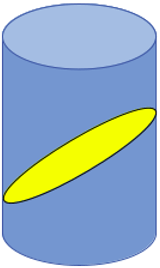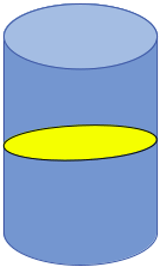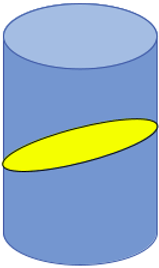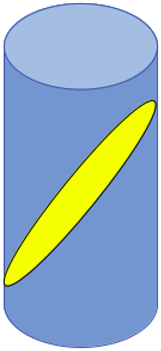This set of Mechanical Metallurgy Problems focuses on “Plastic Deformation of Single Crystal – Critical Resolved Shear Stress”.
1. The unit of dislocation density is ___________
a) m
b) m2
c) m-2
d) m3
View Answer
Explanation: Dislocation density is defined as the length of dislocation in unit volume. Or the number of dislocations cutting through a cross sectional area.
=> m/m3=m-2.
2. Find the shear strain in the material if the burger vector of dislocation is 0.1nm, average distance moved by dislocation is 1 micron, and dislocation density is 108 m-2?
a) 10
b) 108
c) 10-8
d) 10-10
View Answer
Explanation: Shear strain in terms of the dislocation density is defined as:
γ=bρx
Shear strain = 0.1*10-9 *108*10-6
Shear strain = 10-8
3. Shear strain rate is equal to _____
a) bρx
b) bρv
c) ρv
d) bv
View Answer
Explanation: Shear strain in terms of the dislocation density is defined as:
γ=bρx
Shear strain rate in the change in the value of shear strain with time:
b ρ\((\bar{x}/t)\)
=> \(b \rho\bar{v}\)
4. Slip begins when the shearing stress on the slip plane in the slip direction reaches a threshold value called the critical resolved shear stress.
a) True
b) False
View Answer
Explanation: The extent of the slip in a single crystal depends on the magnitude of the shearing stress produced by external loads, the geometry of the crystal structure, and the orientation of the active slip planes concerning the shearing stresses. Slip begins when the shearing stress on the slip plane in the slip direction reaches a threshold value called the critical resolved shear stress.
5. Determine the angle between the [110] axis of a copper crystal with (11-1)[0-11] slip system?
a) 35.26 and 30
b) 30 and 60
c) 30 and 45
d) 60 and 35.26
View Answer
Explanation: Angle is given as:
\(cos\theta=\frac{h1h2+k1k2+l1l2}{(h1^2+k1^2+l1^2)^{(1/2)}*(h2^2+k2^2+l2^2)^{(1/2)}}\)
With [110] and (11-1):
Cosϴ=1+1/{(12+12)1/2 *(12+12+12)1/2}
=> 2/(61/2)
=> Cosϴ=√(2/3)
ϴ=35.264
With [110] and (0-11):
Cosϴ=-1/{(12+12)1/2 *(02+(-1)2+12)1/2}
Cosϴ=-1/2
ϴ=120=30-degree negative.
6. Determine the tensile stress that is applied along the [1-10] axis of a silver crystal to cause slip on the (1-1-1) [0-11] system. The critical resolved shear stress is 10 MPa.
a) 10
b) 10√2
c) 10√6
d) 10/√6
View Answer
Explanation: The angle is given as:
\(cos\theta=\frac{h1h2+k1k2+l1l2}{(h1^2+k1^2+l1^2)^{(1/2)}*(h2^2+k2^2+l2^2)^{(1/2)}}\)
Between [1-10] and (1-1-1): cosϴ=2/√6
Between [1-10] and [0-11]: cosϴ=1/2
Critical resolves shear stress is defined as:
10=(P/A) 2/√6*1/2
Tensile stress=10√6
7. The highest value of the critical resolved shear stress will be obtained in which of the following case?
a) 
b) 
c) 
d) 
View Answer
Explanation: The CRSS is equal r = (P/A)cosα cosδ
The multiplication of cosα and cosδ should be maximum for the highest cross.
In case when δ and α = 45 degrees the critical resolved shear stress will be maximum.
8. How the addition of impurity in pure metal affects the critical solved shear stress?
a) Increases
b) decreases
c) Remains unaffected
d) Cannot be predicted
View Answer
Explanation: The presence of an impurity in the lattice will hinder the free movement of dislocation. This result in an increase in critical resolved shear stress. The data shows the importance of small amounts of impurities in increasing the critical resolved shear stress for silver and copper.
9. The ratio of the resolved shear stress to the axial stress is called the Schmid factor m.
a) True
b) False
View Answer
Explanation: The ratio of the resolved shear stress to the axial stress is called the Schmid factor m. For a single crystal loaded in tension or compression along its axis, m = cosα*cosδ.
10. Which two metal shows the significant strain hardening among Cu, Al, Mg, Zn?
a) Cu, Al
b) Mg, Zn
c) Cu, Mg
d) Al, Zn
View Answer
Explanation: Cu, Al=FCC; Mg, Zn=HCP
So, with an increase in critical resolved shear stress, the glide shear strain also increases in HCP Material; whereas FCC glide shear strain variation with the cross is very low, which causes strain hardening.
11. In slip, the orientation of the crystal above and below the slip plane is _________ after deformation as before. While twinning results in ___________ orientation across the twin plane.
a) same, different
b) different, same
c) same, same
d) different, different
View Answer
Explanation: In slip, the orientation of the crystal above and below the slip plane is the same after deformation as before, while twinning results in an orientation difference across the twin plane. Slip is usually considered to occur in discrete multiples of the atomic spacing, while in twinning the atom movements are much less than an atomic distance.
12. Which of the following is not a favorable condition for the formation of mechanical twins?
a) The rapid rate of loading
b) Low temperature
c) BCC or HCP lattice
d) Higher temperature
View Answer
Explanation: The twin formed due to mechanical deformation of the material is known to be mechanical twins. Mechanical twins are produced in BCC or HCP metals under conditions of the rapid rate of loading (shock loading) and decreased temperature.
Sanfoundry Global Education & Learning Series – Mechanical Metallurgy.
To practice all areas of Mechanical Metallurgy Problems, here is complete set of 1000+ Multiple Choice Questions and Answers.
If you find a mistake in question / option / answer, kindly take a screenshot and email to [email protected]
- Check Metallurgical Engineering Books
- Apply for Metallurgical Engineering Internship
- Practice Metallurgical Engineering MCQs
- Check Mechanical Metallurgy Books
